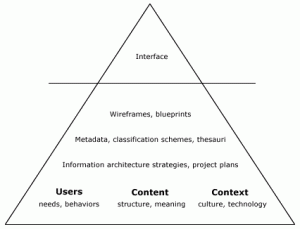Algorithms change the game every day and it is harder to use little tricks and game the engines these days. At some point we all have to put on our white hat and dig in. We want innovations based on relevant content, efficient CMS and great link relationships. Innovations like this come from information architecture enhancements.
This is how Wikipedia defines the role of Information Architecture (IA):
…it involves the categorization of information into a coherent structure, preferably one that the intended audience can understand quickly, if not inherently, and then easily retrieve the information for which they are searching.
Its a new set of jargon but onsite SEO is information architecture optimization.
Just like many large scale sites struggle with SEO they are also struggling with IA. Most aren’t aware of it either. This struggle is know as the IA iceberg problem.
Business leaders and designers will focus on the visible interface without appreciating the invisible structures, supporting information and content relationships.
Many organizations have top tier designers and SEO’s but not all have IA experts. This iceberg is the reason large scale projects sink and flounder into oblivion. These challenges are generally out of reach for both SEO’s and designers and a middle ground has to be found.
SEO’s have a natural grasp of identifying these issues though. They are already focused on meta data, site structures, relevance and user needs. This iceberg issue presents large opportunities for SEO’s moving into large scale projects.
Large scale SEO lies within the confines of information architecture innovations. The difference is that these innovations are for website users and not just external search engines.
Join the new W3c community group for Information Architecture.
Read more at UX Magazine as they look for ways to expand their conversations.

